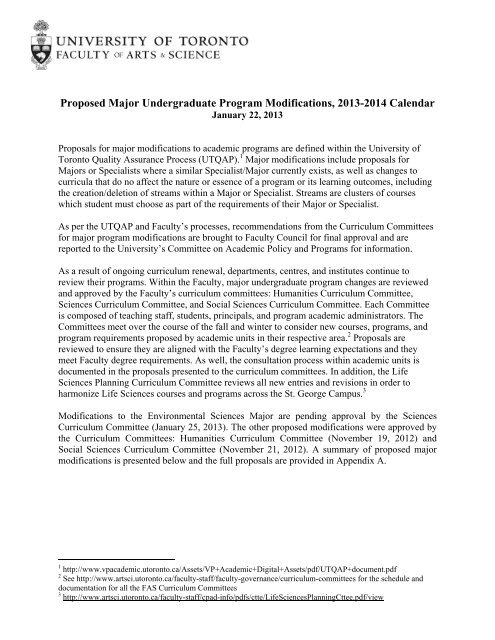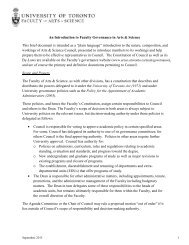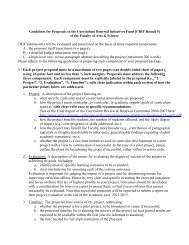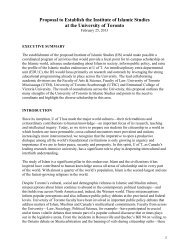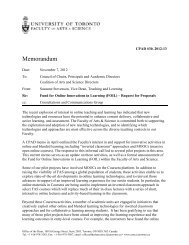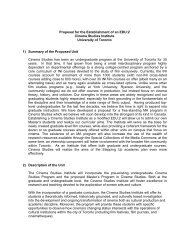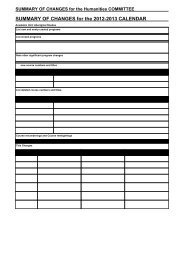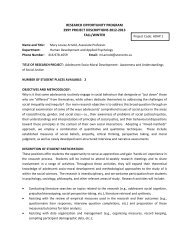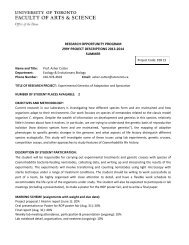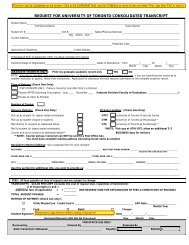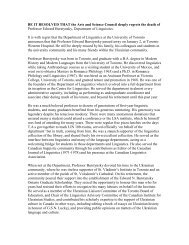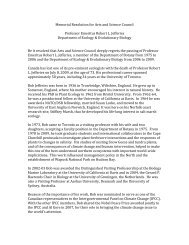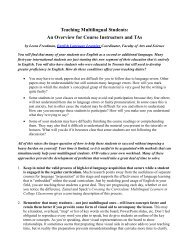Undergraduate Major Program Modifications - the Faculty of Arts ...
Undergraduate Major Program Modifications - the Faculty of Arts ...
Undergraduate Major Program Modifications - the Faculty of Arts ...
You also want an ePaper? Increase the reach of your titles
YUMPU automatically turns print PDFs into web optimized ePapers that Google loves.
Proposed <strong>Major</strong> <strong>Undergraduate</strong> <strong>Program</strong> <strong>Modifications</strong>, 2013-2014 Calendar<br />
January 22, 2013<br />
Proposals for major modifications to academic programs are defined within <strong>the</strong> University <strong>of</strong><br />
Toronto Quality Assurance Process (UTQAP). 1 <strong>Major</strong> modifications include proposals for<br />
<strong>Major</strong>s or Specialists where a similar Specialist/<strong>Major</strong> currently exists, as well as changes to<br />
curricula that do no affect <strong>the</strong> nature or essence <strong>of</strong> a program or its learning outcomes, including<br />
<strong>the</strong> creation/deletion <strong>of</strong> streams within a <strong>Major</strong> or Specialist. Streams are clusters <strong>of</strong> courses<br />
which student must choose as part <strong>of</strong> <strong>the</strong> requirements <strong>of</strong> <strong>the</strong>ir <strong>Major</strong> or Specialist.<br />
As per <strong>the</strong> UTQAP and <strong>Faculty</strong>’s processes, recommendations from <strong>the</strong> Curriculum Committees<br />
for major program modifications are brought to <strong>Faculty</strong> Council for final approval and are<br />
reported to <strong>the</strong> University’s Committee on Academic Policy and <strong>Program</strong>s for information.<br />
As a result <strong>of</strong> ongoing curriculum renewal, departments, centres, and institutes continue to<br />
review <strong>the</strong>ir programs. Within <strong>the</strong> <strong>Faculty</strong>, major undergraduate program changes are reviewed<br />
and approved by <strong>the</strong> <strong>Faculty</strong>’s curriculum committees: Humanities Curriculum Committee,<br />
Sciences Curriculum Committee, and Social Sciences Curriculum Committee. Each Committee<br />
is composed <strong>of</strong> teaching staff, students, principals, and program academic administrators. The<br />
Committees meet over <strong>the</strong> course <strong>of</strong> <strong>the</strong> fall and winter to consider new courses, programs, and<br />
program requirements proposed by academic units in <strong>the</strong>ir respective area. 2 Proposals are<br />
reviewed to ensure <strong>the</strong>y are aligned with <strong>the</strong> <strong>Faculty</strong>’s degree learning expectations and <strong>the</strong>y<br />
meet <strong>Faculty</strong> degree requirements. As well, <strong>the</strong> consultation process within academic units is<br />
documented in <strong>the</strong> proposals presented to <strong>the</strong> curriculum committees. In addition, <strong>the</strong> Life<br />
Sciences Planning Curriculum Committee reviews all new entries and revisions in order to<br />
harmonize Life Sciences courses and programs across <strong>the</strong> St. George Campus. 3<br />
<strong>Modifications</strong> to <strong>the</strong> Environmental Sciences <strong>Major</strong> are pending approval by <strong>the</strong> Sciences<br />
Curriculum Committee (January 25, 2013). The o<strong>the</strong>r proposed modifications were approved by<br />
<strong>the</strong> Curriculum Committees: Humanities Curriculum Committee (November 19, 2012) and<br />
Social Sciences Curriculum Committee (November 21, 2012). A summary <strong>of</strong> proposed major<br />
modifications is presented below and <strong>the</strong> full proposals are provided in Appendix A.<br />
1 http://www.vpacademic.utoronto.ca/Assets/VP+Academic+Digital+Assets/pdf/UTQAP+document.pdf<br />
2 See http://www.artsci.utoronto.ca/faculty-staff/faculty-governance/curriculum-committees for <strong>the</strong> schedule and<br />
documentation for all <strong>the</strong> FAS Curriculum Committees<br />
3 http://www.artsci.utoronto.ca/faculty-staff/cpad-info/pdfs/ctte/LifeSciencesPlanningCttee.pdf/view
Summary <strong>of</strong> proposed major program modifications for 2013-14 Calendar<br />
School <strong>of</strong> <strong>the</strong> Environment<br />
Environmental Science <strong>Major</strong><br />
Change <strong>of</strong> program name and redesign <strong>of</strong> <strong>the</strong> program<br />
Environment, natural resources and related programs and courses at <strong>the</strong> undergraduate level are<br />
<strong>of</strong>fered by several units within <strong>the</strong> <strong>Faculty</strong> <strong>of</strong> <strong>Arts</strong> & Science. The Working Group on<br />
Environment, Resources and Related <strong>Program</strong>s was established by <strong>the</strong> <strong>Faculty</strong> in <strong>the</strong> spring <strong>of</strong><br />
2011 in order to assess <strong>the</strong> current organization <strong>of</strong> <strong>the</strong>se programs and make recommendations to<br />
<strong>the</strong> <strong>Faculty</strong>. Following <strong>the</strong> <strong>Faculty</strong>-wide consultations in Fall 2011 and <strong>the</strong> Final Report on <strong>the</strong><br />
Environment, a new Environmental Science <strong>Program</strong> committee was established in spring 2012.<br />
This committee consisted <strong>of</strong> undergraduate and graduate students and faculty currently teaching<br />
environmental science courses, both within <strong>the</strong> School <strong>of</strong> <strong>the</strong> Environment and <strong>the</strong>ir home<br />
departments. Departments represented included: Anthropology/Archaeology, Chemistry,<br />
Ecology and Evolutionary Biology, Earth Sciences, Geography, Physics and <strong>the</strong> School <strong>of</strong> <strong>the</strong><br />
Environment. The committee reviewed existing top Environmental Science programs, consulted<br />
with colleagues at peer institutions and engaged in an in-depth discussion <strong>of</strong> <strong>the</strong> learning<br />
outcomes, program requirements and focus <strong>of</strong> <strong>the</strong> program. Consultations took place throughout<br />
this process with chairs and associate chairs-undergraduate to discuss overlap <strong>of</strong><br />
courses/programs, interest in involvement in <strong>the</strong> program and o<strong>the</strong>r issues. Subsequent<br />
consultation with undergraduate students has also involved a call to an open<br />
information/consultation meeting to discuss <strong>the</strong> proposed program and its implications for inprogram<br />
students (i.e., no impact to students wanting to complete <strong>the</strong> existing Environment and<br />
Science major).<br />
The committee proposes <strong>the</strong> name <strong>of</strong> <strong>the</strong> program be changed from Environment & Science to<br />
Environmental Science. This is to reflect <strong>the</strong> enhanced science curriculum in <strong>the</strong> revised<br />
program and to bring <strong>the</strong> name <strong>of</strong> <strong>the</strong> major in line with current programs at competitor<br />
institutions. The name Environmental Science is also important for students’ potential graduate<br />
school or career choices as it signifies a certain type <strong>of</strong> interdisciplinary scientific training related<br />
to environmental issues.<br />
The major modification to <strong>the</strong> program also includes clarification and refinement <strong>of</strong> learning<br />
objectives to enhance Environmental Science components and a redesign <strong>of</strong> <strong>the</strong> program to<br />
provide a better structure—centered around learning objectives—and providing a clear<br />
progression <strong>of</strong> required courses at <strong>the</strong> 200-, 300- and 400-level. Changes in <strong>the</strong> program<br />
requirements are <strong>the</strong> following:<br />
a) revised admissions requirements;<br />
b) required core science courses at <strong>the</strong> 200- and 300-level, including Environmental Scienceonly<br />
labs for ENV234H1;<br />
c) new 200-level Physics course designed to integrate physics concepts and methods with<br />
Environmental Science issues;<br />
d) required 300-level Laboratory and Field Methods Techniques course to ensure students are<br />
exposed to interdisciplinary data collection and analysis methods used by Environmental<br />
Scientists; and,<br />
e) science-based 400-level course options, with more to be developed and approved through<br />
governance in subsequent years.
Department <strong>of</strong> Near and Middle Eastern Civilizations<br />
Near and Middle Eastern Civilizations (NMC) – <strong>Major</strong> and Specialist<br />
New streams: General (roughly equivalent to current program), Ancient, Medieval, and Modern.<br />
We are proposing to revise <strong>the</strong> program in order to <strong>of</strong>fer more nuance for UG study. A single<br />
“NMC” POSt affirms that <strong>the</strong> connections between all fields in our department are numerous,<br />
strong, and interwoven, though <strong>the</strong> disciplines, times, and areas covered are diverse. The streams<br />
provide <strong>the</strong> best <strong>of</strong> all worlds: signaling unity and coherence <strong>of</strong> studying near and middle-eastern<br />
civilizations while allowing students to focus <strong>the</strong>ir studies within one <strong>of</strong> <strong>the</strong> new streams. The<br />
proposal highlights:<br />
- The creation <strong>of</strong> four streams for <strong>the</strong> specialist and major programs: General (which roughly<br />
corresponds to <strong>the</strong> current program), Ancient, Medieval, and Modern. For <strong>the</strong> <strong>Major</strong>, <strong>the</strong><br />
streams consist <strong>of</strong> 5 FCEs (including 1-2 FCEs in <strong>the</strong> relevant languages). For <strong>the</strong> Specialist,<br />
<strong>the</strong> streams consist <strong>of</strong> 6 FCEs in addition to <strong>the</strong> required 4 FCEs in one or two primary<br />
source languages.<br />
- The overall number <strong>of</strong> courses required in each program is unchanged.<br />
- There are no changes in learning outcomes for <strong>the</strong> General Stream; but addition <strong>of</strong> following<br />
for each period “<strong>the</strong> acquisition <strong>of</strong> knowledge, critical analysis, writing and presentation<br />
skills and experience, and linguistic competency in <strong>the</strong> ancient/medieval/modern period <strong>of</strong><br />
<strong>the</strong> Near and Middle East”.<br />
Rotman Commerce <strong>Program</strong><br />
Accounting Specialist<br />
New streams: Public Accounting (equivalent <strong>of</strong> current program) and Financial Reporting and<br />
Control.<br />
The Public Accounting stream, for which <strong>the</strong> requirements are necessarily restrictive <strong>of</strong> <strong>the</strong> needs<br />
<strong>of</strong> pr<strong>of</strong>essional accreditation, do not allow faculty <strong>the</strong> ability to <strong>of</strong>fer certain important courses<br />
that reflect <strong>the</strong> cutting edge <strong>of</strong> practice and research in accounting. These courses include, in<br />
particular, two new courses: RSM425H1 Theory <strong>of</strong> Financial Reporting and Control and<br />
RSM429H1 Financial Statement Analysis and Valuation. These courses lie more at <strong>the</strong><br />
intersection <strong>of</strong> accounting and finance or accounting and management and are less devoted to <strong>the</strong><br />
functions <strong>of</strong> public accounting (which places a heavy emphasis on fields such as audit and tax<br />
accounting). Accounting students, preparing for an accounting-related career outside <strong>of</strong> public<br />
accounting, should have a broader exposure to o<strong>the</strong>r management disciplines, which this new<br />
stream provides in two ways. First, it requires 1.0 FCE <strong>of</strong> management breadth from <strong>the</strong> nonfinance,<br />
non-accounting disciplines ra<strong>the</strong>r than 0.5 FCE as in <strong>the</strong> public accounting stream.<br />
Second, it provides an additional 1.0 FCE <strong>of</strong> RSM electives because it only requires 9.0 FCE <strong>of</strong><br />
specific RSM courses (while <strong>the</strong> “Public Accounting” stream requires/specifies all 10.0 RSM<br />
FCEs).<br />
- Proposed creation <strong>of</strong> two streams for <strong>the</strong> Specialist: Public Accounting (which is <strong>the</strong><br />
equivalent <strong>of</strong> <strong>the</strong> current program, with 15 FCEs) and Financial Reporting and Control. This<br />
second stream) requires 1 FCE less (14 FCEs overall) and provides more choices among<br />
required courses.<br />
- No changes in learning outcomes for <strong>the</strong> Public Accounting stream. Students in <strong>the</strong> Financial<br />
Reporting and Control stream will not be able to meet <strong>the</strong> post-secondary education<br />
requirements for licensing as a public accountant in Ontario.
<strong>Major</strong> <strong>Modifications</strong>, 2013-14 Calendar Year<br />
Appendix A<br />
PROGRAM PROPOSAL PACKAGE for CALENDAR<br />
NEW STREAMS WITHIN PROGRAM<br />
Department/Unit: Near and Middle Eastern Civilizations<br />
<strong>Program</strong>: Specialist<br />
PART I – Calendar Entry<br />
1. Description<br />
<strong>Program</strong> Description:<br />
The Department <strong>of</strong> Near and Middle Eastern Civilizations is concerned with <strong>the</strong> interdisciplinary study <strong>of</strong> <strong>the</strong> civilizations<br />
and cultures <strong>of</strong> <strong>the</strong> Near and Middle East from Neolithic times until <strong>the</strong> present, including <strong>the</strong>ir archaeology, history,<br />
mythology, religion and thought, art and architecture, and languages and literatures (Akkadian, Babylonian, Sumerian,<br />
Aramaic, Syriac, ancient Egyptian, Hebrew, Arabic, Persian and Turkish). The Department’s programs provide students<br />
with a unique opportunity to study non-Western complex societies and civilizations.<br />
The Near East is generally understood to refer to <strong>the</strong> region at <strong>the</strong> eastern end <strong>of</strong> <strong>the</strong> Mediterranean and beyond, from<br />
ancient times up to <strong>the</strong> advent <strong>of</strong> Islam in <strong>the</strong> seventh century CE. The Middle East begins with <strong>the</strong> advent <strong>of</strong> Islam and<br />
refers to a much broader geographical area whose predominant Islamic culture in medieval and modern times has<br />
stretched to North Africa and Spain in <strong>the</strong> west and to Central Asia, India, and Sou<strong>the</strong>ast Asia in <strong>the</strong> east.<br />
The Department welcomes students <strong>of</strong> all academic backgrounds who wish to learn about <strong>the</strong> Near and Middle East.<br />
NMC101H1, NMC102H1 and NMC104H1 introduce students to <strong>the</strong> ancient Near East, including ancient Egypt,<br />
Mesopotamia, and Israel, while NMC103H1 introduces students to <strong>the</strong> Islamic world. Students pursuing a Specialist or<br />
<strong>Major</strong> program are required to take two <strong>of</strong> <strong>the</strong>se Gateway courses and are given <strong>the</strong> option to enrol in one <strong>of</strong> four streams:<br />
an open stream, an ancient stream, a medieval stream, or a modern stream.<br />
Many courses <strong>of</strong>fered in <strong>the</strong> Department do not require any knowledge <strong>of</strong> <strong>the</strong> languages <strong>of</strong> <strong>the</strong> region. However, <strong>the</strong><br />
Department strongly believes that a deeper understanding <strong>of</strong> <strong>the</strong> civilizations and cultures <strong>of</strong> <strong>the</strong> Near and Middle East can<br />
be achieved through <strong>the</strong> study <strong>of</strong> one or more <strong>of</strong> its languages. In fact, admission to a graduate program in NMC requires<br />
<strong>the</strong> applicant to have acquired a background in languages. Students should consult <strong>the</strong> Department’s web site<br />
www.utoronto.ca/nmc for more detailed information about programs and courses <strong>of</strong>fered in a particular year.<br />
<strong>Undergraduate</strong> Enquiries: 4 Bancr<strong>of</strong>t Avenue, Room 200, nmc@utoronto.ca or Pr<strong>of</strong>. Robert Holmstedt, undergraduate<br />
coordinator (robert.holmstedt@utoronto.ca)<br />
Near and Middle Eastern Civilizations Specialist (<strong>Arts</strong> program) (11 FCEs, including at least 4 300+ FCEs, 1 FCE <strong>of</strong><br />
which must be at <strong>the</strong> 400-level.)<br />
At least 9 FCEs must be NMC and/or NML courses. O<strong>the</strong>rs may be taken only from a list <strong>of</strong> pre-approved courses <strong>of</strong>fered<br />
by o<strong>the</strong>r departments.<br />
1. First Year: 1 FCE from NMC101H1/NMC102H1/NMC103H1/NMC104H1.<br />
2. 4 FCEs in one or two primary source languages (Akkadian, Ancient Egyptian, Biblical, Middle, or Modern Hebrew,<br />
Aramaic, Syriac, Arabic, Persian, Turkish), with NML designator (i.e., not literature in translation). It is recommended<br />
that language instruction begin in first year if possible.<br />
3. Higher years: one <strong>of</strong> <strong>the</strong> four following streams:<br />
NMC Specialist (General) (6 FCEs)<br />
3. 3 FCEs from NMC 241H1, 270H1, 273Y1, 274Y1, 275H1, 277H1, 278H1, 342H1, 343H1, 344H1, 346H1, 347H1,<br />
348Y1, 355H1, 370H1, 373H1, 374H1, 376H1, 377Y1, 378H1, 451H1, 471H1, 472H1, 473H1, 475H1, 476H1, 478H1,<br />
479H1 (History & Society courses) and NMC 283Y1, 284H1, 285H1, 286H1, 289H1, 380Y1, 381H1, 382Y1, 384H1,<br />
385H1, 387H1, 388H1, 389H1, 481H1, 484H1 (Religion & Thought courses).<br />
4. 2 FCEs from NMC 260Y1, 261Y0, 360H1, 361H1, 362Y1, 363H1, 364H1, 365Y1, 366Y1, 367H1, 368H1, 369Y1, 461Y1,<br />
462Y1, 465H1, 466H1, 467H1, 468H1, 469Y1 (Archaeology courses) and NMC 392H1, 393H1, 394H1, 396Y1, 491H1<br />
(Art & Architecture courses).<br />
5. 1 additional FCE <strong>of</strong> NMC or NML courses or those from a list <strong>of</strong> pre-approved courses <strong>of</strong>fered by o<strong>the</strong>r departments.<br />
NMC Specialist (Ancient) (6 FCEs)<br />
2a. The 4 FCEs in primary source languages must be from among <strong>the</strong> following languages: Akkadian, Ancient Egyptian,<br />
Biblical or Middle Hebrew, Aramaic, Syriac.<br />
3. 3 FCEs from NMC 270H1, 277H1, 343H1, 344H1, 346H1, 347H1, 370H1, 472H1 (History & Society courses) and NMC<br />
289H1, 380Y1, 382Y1 (Religion & Thought courses).<br />
1
<strong>Major</strong> <strong>Modifications</strong>, 2013-14 Calendar Year<br />
Appendix A<br />
4. 2 FCEs from NMC 260Y1, 261Y0, 360H1, 361H1, 362Y1, 363H1, 364H1, 366Y1, 369Y1, 461Y1, 462Y1, 465H1, 466H1,<br />
467H1, 468H1 (Archaeology courses) and NMC 491H1 (Art & Architecture course).<br />
5. 1 additional FCE in Medieval or Modern stream courses or those from a list <strong>of</strong> pre-approved courses <strong>of</strong>fered by o<strong>the</strong>r<br />
departments.<br />
NMC Specialist (Medieval) (6 FCEs)<br />
2a. The 4 FCEs in primary source languages must be from among <strong>the</strong> following languages: Biblical or Middle Hebrew,<br />
Aramaic, Syriac, Arabic, Persian, Turkish.<br />
3. 3 FCEs from NMC 270H1, 273Y1, 274Y1, 275H1, 277H1, 342H1, 348Y1, 374H1, 376H1, 377Y1, 471H1, 472H1 (History<br />
& Society courses) and NMC 283Y1, 285H1, 286H1, 289H1, 384H1, 385H1, 387H1, 388H1, 389H1, 481H1, 484H1<br />
(Religion & Thought courses).<br />
4. 2 FCEs from NMC 261Y0, 365Y1, 366Y1, 367H1, 369Y1, 462Y1, 465H1, 469Y1 (Archaeology courses) and NMC<br />
393H1, 394H1, 396Y1 (Art & Architecture courses).<br />
5. 1 additional FCE in Ancient or Modern stream courses or those from a list <strong>of</strong> pre-approved courses <strong>of</strong>fered by o<strong>the</strong>r<br />
departments.<br />
NMC Specialist (Modern) (6 FCEs)<br />
2a. The 4 FCEs in primary source languages must be from among <strong>the</strong> following languages: Modern Hebrew, Arabic,<br />
Persian, Turkish.<br />
3. 3 FCEs from NMC 241H1, 270H1, 274Y1, 277H1, 278H1, 348Y1, 355H1, 373H1, 374H1, 377Y1, 378H1, 451H1,<br />
472H1, 473H1, 475H1, 476H1, 478H1, 479H1 (History & Society courses) and NMC 283Y1, 284H1, 285H1, 286H1,<br />
289H1, 381H1, 384H1, 385H1, 387H1, 389H1, 481H1, 484H1 (Religion & Thought courses).<br />
4. 2 FCEs from NMC 261Y0, 367H1, 368H1, 369Y1, 462Y1, 465H1 (Archaeology courses) and NMC 392H1, 394H1,<br />
396Y1 (Art & Architecture courses).<br />
5. 1 additional FCE in Ancient or Medieval stream courses or those from a list <strong>of</strong> pre-approved courses <strong>of</strong>fered by o<strong>the</strong>r<br />
departments.<br />
2. Academic Context<br />
The non-subtitled “open” NMC stream is maximally flexible and allows students to capitalize on <strong>the</strong> strengths <strong>of</strong><br />
interdisciplinary study within <strong>the</strong> temporal and spatial domain covered by NMC.<br />
The three sub-titled streams (NMC: Ancient, NMC: Medieval, NMC: Modern) provide guidance after <strong>the</strong> first-year courses<br />
for less self-directed students to achieve a transparent coherence in <strong>the</strong>ir NMC studies. The streams also visibly signal<br />
focused preparation in one <strong>of</strong> <strong>the</strong> general historical stages within <strong>the</strong> umbrella <strong>of</strong> Near and Middle Eastern civilizations for<br />
those students who, for job preparation or graduate studies, desire this recognition on <strong>the</strong>ir transcript.<br />
3. Learning Outcomes<br />
The Specialist program in NMC is designed to allow students an intensive training in a complex Humanities program. The<br />
aim <strong>of</strong> <strong>the</strong> Specialist is to allow students to specialize in one <strong>of</strong> <strong>the</strong> many areas <strong>of</strong> study in <strong>the</strong> department with a core <strong>of</strong><br />
language courses that is <strong>the</strong> foundation <strong>of</strong> <strong>the</strong> program. All four streams in <strong>the</strong> Specialist program share <strong>the</strong> same learning<br />
goals, distinguished only by <strong>the</strong> temporal orientation <strong>of</strong> <strong>the</strong> three sub-titled streams:<br />
1. To achieve intermediate to advanced language competency in one or more <strong>of</strong> <strong>the</strong> languages <strong>of</strong> <strong>the</strong> Near and Middle<br />
East. Nine languages are taught in <strong>the</strong> department to <strong>the</strong> intermediate or advanced level: Arabic, Modern Hebrew,<br />
Persian, and Turkish, on <strong>the</strong> modern side; Akkadian, Aramaic/Syriac, Biblical Hebrew, Middle Hebrew, and Ancient<br />
Egyptian on <strong>the</strong> ancient side.<br />
2. To achieve in-depth knowledge <strong>of</strong> <strong>the</strong> historical development <strong>of</strong> <strong>the</strong> Near and Middle East, encompassing <strong>the</strong> political,<br />
religious, cultural, and economic development <strong>of</strong> <strong>the</strong> region including familiarity with <strong>the</strong> methodology <strong>of</strong> historical<br />
investigation, literary analysis and religious history.<br />
3. To acquire <strong>of</strong> critical and analytical thinking skills, including <strong>the</strong> ability to read primary sources critically and develop a<br />
<strong>the</strong>oretical approach to <strong>the</strong> historical and literary history <strong>of</strong> <strong>the</strong> Near and Middle East.<br />
4. To acquire essential writing, organizational and oral communication skills that will allow <strong>the</strong> student to excel in any<br />
environment.<br />
5. To prepare for a variety <strong>of</strong> pr<strong>of</strong>essions or work in a wide spectrum <strong>of</strong> jobs from law, journalism, foreign service, and<br />
museums to NGOs and o<strong>the</strong>r positions for which background knowledge <strong>of</strong> <strong>the</strong> Near and Middle East and <strong>the</strong><br />
analytical skills acquired through study in NMC will provide.<br />
6. The Ancient Stream: to focus <strong>the</strong> acquisition <strong>of</strong> knowledge, critical analysis, writing and presentation skills and<br />
experience, and linguistic competency in <strong>the</strong> ancient period <strong>of</strong> <strong>the</strong> Near and Middle East.<br />
7. The Medieval Stream: to focus <strong>the</strong> acquisition <strong>of</strong> knowledge, critical analysis, writing and presentation skills and<br />
experience, and linguistic competency in <strong>the</strong> medieval period <strong>of</strong> <strong>the</strong> Near and Middle East.<br />
8. The Modern Stream: to focus <strong>the</strong> acquisition <strong>of</strong> knowledge, critical analysis, writing and presentation skills and<br />
experience, and linguistic competency in <strong>the</strong> modern period <strong>of</strong> <strong>the</strong> Near and Middle East.<br />
2
<strong>Major</strong> <strong>Modifications</strong>, 2013-14 Calendar Year<br />
Appendix A<br />
PART II – Internal Information for Governance<br />
4. Rationale and Background Information<br />
We are proposing to revise <strong>the</strong> program in order to <strong>of</strong>fer more nuance for UG study. A single “NMC” POSt affirms that <strong>the</strong><br />
connections between all fields in our department are numerous, strong, and interwoven, though <strong>the</strong> disciplines, times, and<br />
areas covered are diverse. The streams provide <strong>the</strong> best <strong>of</strong> all worlds: signaling unity and coherence <strong>of</strong> studying near and<br />
middle-eastern civilizations while allowing students to focus <strong>the</strong>ir studies within one <strong>of</strong> <strong>the</strong> new streams.<br />
5. Departmental/College Resource Implications<br />
Estimated enrolment per academic year in this program<br />
(please explain)<br />
New courses necessary to mount for this program<br />
Additional instructor requirements<br />
Teaching assistant requirements<br />
Laboratory equipment requirements<br />
Computing resource requirements<br />
Libraries resource requirements<br />
O<strong>the</strong>r<br />
Same as existing: @1700 students (=@1150 FCE)<br />
none<br />
none<br />
Same as existing<br />
Same as existing<br />
Same as existing<br />
Same as existing<br />
N/A<br />
DELETE <strong>the</strong> statement that DOES NOT apply:<br />
I will provide <strong>the</strong>se resources required for this program from my existing budget.<br />
DATE Oct 26, 2012<br />
Name <strong>of</strong> Chair/<strong>Program</strong> Director: Robert Holmstedt (UG coordinator) [in consultation with and<br />
with <strong>the</strong> approval <strong>of</strong> <strong>the</strong> dept. chair, Timothy Harrison]<br />
3
<strong>Major</strong> <strong>Modifications</strong>, 2013-14 Calendar Year<br />
Appendix A<br />
PROGRAM PROPOSAL PACKAGE for CALENDAR<br />
NEW STREAMS WITHIN PROGRAM<br />
Department/Unit: Near and Middle Eastern Civilizations<br />
Underline <strong>the</strong> appropriate category among <strong>the</strong> following two:<br />
<strong>Program</strong>: <strong>Major</strong><br />
PART I – Calendar Entry<br />
1. Description<br />
<strong>Program</strong> Description:<br />
The Department <strong>of</strong> Near and Middle Eastern Civilizations is concerned with <strong>the</strong> interdisciplinary study <strong>of</strong> <strong>the</strong> civilizations and<br />
cultures <strong>of</strong> <strong>the</strong> Near and Middle East from Neolithic times until <strong>the</strong> present, including <strong>the</strong>ir archaeology, history, mythology,<br />
religion and thought, art and architecture, and languages and literatures (Akkadian, Babylonian, Sumerian, Aramaic, Syriac,<br />
ancient Egyptian, Hebrew, Arabic, Persian and Turkish). The Department’s programs provide students with a unique<br />
opportunity to study non-Western complex societies and civilizations.<br />
The Near East is generally understood to refer to <strong>the</strong> region at <strong>the</strong> eastern end <strong>of</strong> <strong>the</strong> Mediterranean and beyond, from<br />
ancient times up to <strong>the</strong> advent <strong>of</strong> Islam in <strong>the</strong> seventh century CE. The Middle East begins with <strong>the</strong> advent <strong>of</strong> Islam and refers<br />
to a much broader geographical area whose predominant Islamic culture in medieval and modern times has stretched to<br />
North Africa and Spain in <strong>the</strong> west and to Central Asia, India, and Sou<strong>the</strong>ast Asia in <strong>the</strong> east.<br />
The Department welcomes students <strong>of</strong> all academic backgrounds who wish to learn about <strong>the</strong> Near and Middle East.<br />
NMC101H1, NMC102H1 and NMC104H1 introduce students to <strong>the</strong> ancient Near East, including ancient Egypt, Mesopotamia,<br />
and Israel, while NMC103H1 introduces students to <strong>the</strong> Islamic world. Students pursuing a Specialist or <strong>Major</strong> program are<br />
required to take two <strong>of</strong> <strong>the</strong>se Gateway courses and are given <strong>the</strong> option to enrol in one <strong>of</strong> four streams: an open stream, an<br />
ancient stream, a medieval stream, or a modern stream.<br />
Many courses <strong>of</strong>fered in <strong>the</strong> Department do not require any knowledge <strong>of</strong> <strong>the</strong> languages <strong>of</strong> <strong>the</strong> region. However, <strong>the</strong><br />
Department strongly believes that a deeper understanding <strong>of</strong> <strong>the</strong> civilizations and cultures <strong>of</strong> <strong>the</strong> Near and Middle East can be<br />
achieved through <strong>the</strong> study <strong>of</strong> one or more <strong>of</strong> its languages. In fact, admission to a graduate program in NMC requires <strong>the</strong><br />
applicant to have acquired a background in languages. Students should consult <strong>the</strong> Department’s web site<br />
www.utoronto.ca/nmc for more detailed information about programs and courses <strong>of</strong>fered in a particular year.<br />
<strong>Undergraduate</strong> Enquiries: 4 Bancr<strong>of</strong>t Avenue, Room 200, nmc@utoronto.ca or Pr<strong>of</strong>. Robert Holmstedt, undergraduate<br />
coordinator (robert.holmstedt@utoronto.ca)<br />
Near and Middle Eastern Civilizations <strong>Major</strong> (<strong>Arts</strong> program) (6 FCEs including at least 2 300+-level FCEs, 1 FCE <strong>of</strong> which<br />
must be at <strong>the</strong> 400-level)<br />
At least 5 FCEs must be NMC and/or NML courses. 1 FCE may be taken from a list <strong>of</strong> pre-approved courses <strong>of</strong>fered by o<strong>the</strong>r<br />
departments.<br />
1. First Year: 1 FCE from NMC101H1/NMC102H1/NMC103H1/NMC104H1.<br />
2. Higher years: one <strong>of</strong> <strong>the</strong> four following streams.<br />
NMC <strong>Major</strong> (General) (5 FCEs)<br />
2. 3 to 4 FCEs from any NMC courses.<br />
3. 1 to 2 FCEs FCEs in language (NML courses).<br />
NMC <strong>Major</strong> (Ancient Stream) (5 FCEs)<br />
2. 2 to 3 FCEs from Group A and 1 FCEs from Group B/Group C.<br />
3. 1 to 2 FCEs in Ancient Stream languages (Akkadian, Ancient Egyptian, Biblical or Middle Hebrew, Aramaic, Syriac)<br />
NMC <strong>Major</strong> (Medieval Stream) (5 FCEs)<br />
2. 2 to 3 FCEs from Group B and 1 FCEs from Group A/Group C.<br />
3. 1 to 2 FCEs in Medieval Stream languages (Biblical, Middle Hebrew, Aramaic, Syriac, Arabic, Persian, Turkish).<br />
NMC <strong>Major</strong> (Modern Stream) (5 FCEs)<br />
2. 2 to 3 FCEs from Group C and 1 FCEs from Group A/Group B.<br />
3. 1 to 2 FCEs in Modern Stream languages (Modern Hebrew, Arabic, Persian, Turkish).<br />
4
<strong>Major</strong> <strong>Modifications</strong>, 2013-14 Calendar Year<br />
Appendix A<br />
NMC Groups<br />
Group A (Ancient Stream)<br />
NMC 250H, 251H 252H, 253H, 260Y, 261Y, 270H, 277H, 289H, 299Y, 343H, 344H, 346H, 347H, 351H, 360H, 361H,<br />
362Y, 363H, 364H, 366Y, 369Y, 370H, 380Y, 382Y, 399Y, 450H, 461Y, 462Y, 465H, 466H, 467H, 468H, 472H, 491H, 495Y,<br />
496H, 497H, 499Y.<br />
Group B (Medieval Stream)<br />
NMC 258H, 261Y, 270H, 273Y, 274Y, 275H, 277H, 283Y, 285H, 286H, 289H, 299Y, 342H, 348Y, 350H, 365Y, 366Y,<br />
367H, 369Y, 374H, 376H, 377Y, 384H, 385H, 387H, 388H, 389H, 393H, 394H, 396Y, 399Y, 462Y, 465H, 469Y,<br />
471H, 472H, 481H, 484H, 495Y, 496H, 497H, 499Y.<br />
Group C (Modern Stream)<br />
NMC 241H, 255H, 258H, 261Y, 270H, 274Y, 277H, 278H, 283Y, 284H, 285H, 286H, 289H, 299Y, 348Y, 355H,<br />
367H, 368H, 369Y, 373H, 374H, 377Y, 378H, 381H, 384H, 385H, 387H, 389H, 392H, 394H, 396Y, 399Y, 451H,<br />
462Y, 465H, 472H, 473H, 475H, 476H, 478H, 479H, 481H, 484H, 495Y, 496H, 497H, 499Y.<br />
2. Academic Context<br />
The non-subtitled “open” NMC stream is maximally flexible and allows students to capitalize on <strong>the</strong> strengths <strong>of</strong><br />
interdisciplinary study within <strong>the</strong> temporal and spatial domain covered by NMC.<br />
The three sub-titled streams (NMC: Ancient, NMC: Medieval, NMC: Modern) provide guidance for less self-directed students<br />
to achieve a transparent coherence in <strong>the</strong>ir NMC studies. The streams also visibly signal focused preparation in one <strong>of</strong> <strong>the</strong><br />
general historical stages within <strong>the</strong> umbrella <strong>of</strong> Near and Middle Eastern civilizations for those students who, for job<br />
preparation or graduate studies, desire this recognition on <strong>the</strong>ir transcript.<br />
3. Learning Outcomes<br />
The <strong>Major</strong> program in NMC is designed to allow students an in-depth training in a complex Humanities program. All four<br />
streams in <strong>the</strong> <strong>Major</strong> program share <strong>the</strong> same learning goals, differing only in <strong>the</strong> temporal orientation <strong>of</strong> <strong>the</strong> three sub-titled<br />
streams:<br />
1. To achieve in-depth knowledge <strong>of</strong> one <strong>of</strong> <strong>the</strong> ten areas <strong>of</strong> study <strong>of</strong>fered in <strong>the</strong> Department, including familiarity with <strong>the</strong><br />
methodologies <strong>of</strong> that particular area.<br />
2. To acquire critical and analytical thinking skills, including <strong>the</strong> possibility <strong>of</strong> learning to read primary sources.<br />
3. To acquire essential writing, organizational and oral communication skills that will allow <strong>the</strong> student to excel in any<br />
environment.<br />
4. To achieve basic competency in a primary language <strong>of</strong> <strong>the</strong> spoken or written cultural discourse <strong>of</strong> <strong>the</strong> Near and Middle<br />
East.<br />
5. To prepare for a variety <strong>of</strong> pr<strong>of</strong>essions or work in a wide spectrum <strong>of</strong> jobs, including law, journalism, government and<br />
foreign service, museums, NGOs, and commerce for which background knowledge <strong>of</strong> <strong>the</strong> Near and Middle East and <strong>the</strong><br />
analytical skills acquired through study in NMC will be <strong>of</strong> value.<br />
6. The Ancient Stream: to focus <strong>the</strong> acquisition <strong>of</strong> knowledge, critical analysis, writing and presentation skills and experience,<br />
and linguistic competency in <strong>the</strong> ancient period <strong>of</strong> <strong>the</strong> Near and Middle East.<br />
7. The Medieval Stream: to focus <strong>the</strong> acquisition <strong>of</strong> knowledge, critical analysis, writing and presentation skills and<br />
experience, and linguistic competency in <strong>the</strong> medieval period <strong>of</strong> <strong>the</strong> Near and Middle East.<br />
8. The Modern Stream: to focus <strong>the</strong> acquisition <strong>of</strong> knowledge, critical analysis, writing and presentation skills and experience,<br />
and linguistic competency in <strong>the</strong> modern period <strong>of</strong> <strong>the</strong> Near and Middle East.<br />
PART II – Internal Information for Governance<br />
4. Rationale and Background Information<br />
We are proposing to revise <strong>the</strong> program in order to <strong>of</strong>fer more nuance for UG study. A single “NMC” POSt affirms that <strong>the</strong><br />
connections between all fields in our department are numerous, strong, and interwoven, though <strong>the</strong> disciplines, times, and<br />
areas covered are diverse. The streams provide <strong>the</strong> best <strong>of</strong> all worlds: signaling unity and coherence <strong>of</strong> studying N&ME<br />
civilizations while allowing students to focus <strong>the</strong>ir studies within one <strong>of</strong> <strong>the</strong> new streams.<br />
5. Departmental/College Resource Implications<br />
5
<strong>Major</strong> <strong>Modifications</strong>, 2013-14 Calendar Year<br />
Estimated enrolment per academic year in this program<br />
(please explain)<br />
New courses necessary to mount for this program<br />
Additional instructor requirements<br />
Teaching assistant requirements<br />
Laboratory equipment requirements<br />
Computing resource requirements<br />
Libraries resource requirements<br />
O<strong>the</strong>r<br />
Appendix A<br />
Same as existing: 164 students (2012)<br />
none<br />
none<br />
Same as existing<br />
Same as existing<br />
Same as existing<br />
Same as existing<br />
N/A<br />
DELETE <strong>the</strong> statement that DOES NOT apply:<br />
I will provide <strong>the</strong>se resources required for this program from my existing budget.<br />
DATE Oct 26, 2012<br />
Name <strong>of</strong> Chair/<strong>Program</strong> Director: Robert Holmstedt (UG coordinator) [in consultation with and with<br />
<strong>the</strong> approval <strong>of</strong> <strong>the</strong> dept. chair, Timothy Harrison]<br />
6
<strong>Major</strong> <strong>Modifications</strong>, 2013-14 Calendar Year<br />
Appendix A<br />
PROGRAM PROPOSAL FORM for 2012-2013 CALENDAR<br />
NEW STREAMS WITHIN PROGRAM<br />
Department/Unit: Rotman Commerce<br />
<strong>Program</strong>: Accounting Specialist (BCom)<br />
PART I – Calendar Entry<br />
1. Description<br />
Rotman Commerce at <strong>the</strong> University <strong>of</strong> Toronto <strong>of</strong>fers an innovative curriculum combining studies in management,<br />
economics, and <strong>the</strong> liberal arts for an enriched pr<strong>of</strong>essional undergraduate experience. The program explores <strong>the</strong> role <strong>of</strong><br />
commerce in modern society while developing skill and confidence in analysis, effective communications and decision<br />
making.<br />
The Bachelor <strong>of</strong> Commerce degree builds on a common foundation <strong>of</strong> business and liberal arts courses. Rotman<br />
Commerce students go on to specialize in one <strong>of</strong> three programs: Accounting, Finance & Economics or Management.<br />
Each program combines courses in management and applied economics with a variety <strong>of</strong> courses in <strong>the</strong> <strong>Arts</strong> & Sciences.<br />
The balance assures graduates <strong>of</strong> a solid understanding <strong>of</strong> business and modern society along with a command <strong>of</strong> critical<br />
skills in decision-making and organizational leadership.<br />
Rotman Commerce graduates frequently become economists, accountants, actuaries, financial analysts, marketing<br />
analysts, managers in firms and government, or proprietors <strong>of</strong> small businesses. Some commerce students elect to<br />
undertake post-graduate studies in <strong>the</strong> form <strong>of</strong> fur<strong>the</strong>r university education: law schools and MBA programs have been<br />
particularly favoured destinations <strong>of</strong> recent graduates.<br />
To qualify for a Bachelor <strong>of</strong> Commerce degree, a student must:<br />
(a) Complete twenty full-course equivalents, including no more than six 100-series courses;<br />
(b) Complete one <strong>of</strong> <strong>the</strong> Specialist programs – Accounting, Finance & Economics or Management (see below);<br />
(c) Complete <strong>the</strong> <strong>Faculty</strong> Breadth Requirement for BCom students (see below);<br />
(d) Complete ten full course equivalents from Management (RSM) and ten full course equivalents from disciplines outside <strong>of</strong><br />
RSM which include Economics (ECO) and o<strong>the</strong>r <strong>Arts</strong> & Science courses.<br />
(e) Obtain standing (i.e., complete with a grade <strong>of</strong> 50% or more) in at least six 300- or 400-series courses, including at least<br />
one 400-series course. No more than one 300+series transfer credit may be counted towards <strong>the</strong>se six. (Students<br />
participating in an approved exchange program may count all 300+ transfer credits from <strong>the</strong> exchange towards <strong>the</strong><br />
required six.)<br />
(f) Achieve a cumulative GPA <strong>of</strong> 1.85 or more by <strong>the</strong> time <strong>of</strong> graduation.<br />
Notes<br />
•Enrolment in <strong>the</strong> Rotman Commerce program is limited. Most students are admitted to first-year with a Rotman Commerce<br />
Admission Guarantee (see below for terms and conditions <strong>of</strong> <strong>the</strong> guarantee). Formal program enrolment takes place in <strong>the</strong><br />
second-year, provided that <strong>the</strong> conditions <strong>of</strong> <strong>the</strong> guarantee have been met. A limited number <strong>of</strong> spaces may also be<br />
available in second-year for o<strong>the</strong>r <strong>Arts</strong> & Science students who were not admitted with <strong>the</strong> Admission Guarantee (see<br />
section on “O<strong>the</strong>r Students” for specific admission criteria).<br />
• First-Year Students Admitted with <strong>the</strong> Rotman Commerce Admission Guarantee:<br />
Students admitted with <strong>the</strong> Rotman Commerce Admission Guarantee will be invited to enroll in <strong>the</strong> program after first-year,<br />
provided that <strong>the</strong> following requirements have been met:<br />
Complete RSM100Y Introduction to Management with a mark <strong>of</strong> at least 67%<br />
Complete ECO100Y Introduction to Economics with a mark <strong>of</strong> at least 67%<br />
Complete MAT133Y Calculus and Linear Algebra for Commerce (or equivalent) with a mark <strong>of</strong> at least 63%<br />
Accumulate a minimum <strong>of</strong> 4.0 credits<br />
These requirements must be met within one calendar year <strong>of</strong> <strong>the</strong>ir first enrolment in <strong>Arts</strong> & Science. For students beginning<br />
in September, <strong>the</strong> requirements must be satisfied no later than <strong>the</strong> end <strong>of</strong> <strong>the</strong> following Summer Session.<br />
Students may repeat any <strong>of</strong> <strong>the</strong> required courses once, in order to attain <strong>the</strong> requisite mark. The repeated course(s) must be<br />
completed within <strong>the</strong> calendar year (as per <strong>the</strong> terms <strong>of</strong> <strong>the</strong> guarantee); as such, <strong>the</strong> repeated course(s) must be taken<br />
7
<strong>Major</strong> <strong>Modifications</strong>, 2013-14 Calendar Year<br />
Appendix A<br />
during <strong>the</strong> Summer Session <strong>of</strong> first-year (i.e. a student may not extend <strong>the</strong> terms <strong>of</strong> her/his guarantee in order to attain <strong>the</strong><br />
minimum marks).<br />
Failure to meet any <strong>of</strong> <strong>the</strong> above, or failure to finish all <strong>the</strong> required courses by <strong>the</strong> end <strong>of</strong> <strong>the</strong> Summer after first year<br />
(assuming full-time studies) will result in losing <strong>the</strong> admission guarantee. None <strong>of</strong> <strong>the</strong>se courses may be completed using<br />
<strong>the</strong> CR/NCR option.<br />
•Part-Time Students:<br />
Students holding <strong>the</strong> Rotman Commerce Admission Guarantee, who have applied for and been admitted to Part-Time<br />
study, will be assessed for entry into Rotman Commerce programs at <strong>the</strong> point when <strong>the</strong>y have completed 4.0 credits<br />
including <strong>the</strong> required courses (see above for <strong>the</strong> requirements <strong>of</strong> <strong>the</strong> guarantee). To qualify under <strong>the</strong> Part-Time provision,<br />
students must have been enrolled in a part-time course load from <strong>the</strong> beginning <strong>of</strong> each session. Part-time students may<br />
repeat each <strong>of</strong> <strong>the</strong> required courses once in order to attain <strong>the</strong> minimum marks.<br />
• O<strong>the</strong>r Students:<br />
A limited number <strong>of</strong> spaces in Rotman Commerce may be available to <strong>Arts</strong> & Science students who were not admitted to<br />
first-year with <strong>the</strong> Rotman Commerce Admission Guarantee. The number <strong>of</strong> spaces available is determined annually but is<br />
generally fewer than 20.<br />
Applications are submitted in late-April/May <strong>of</strong> each year and admission decisions are made and communicated in late-<br />
June. All admission requirements must be completed by May 1 in order to be eligible for admission. Students who have not<br />
completed <strong>the</strong> necessary requirements (see below for specifics) by May 1 must apply for admission <strong>the</strong> following year.<br />
Admission Requirements:<br />
Complete RSM100Y1 and ECO100Y1, each with a mark <strong>of</strong> at least 67%<br />
Complete one <strong>of</strong> MAT133Y1/(135H1, 136H1)/137Y1/(123H1, 124H1)/(125H1, 126H1), with a mark <strong>of</strong> at least 63%<br />
Attain an average <strong>of</strong> at least 73% across <strong>the</strong> 3 qualifying courses (RSM100Y1, ECO100Y1 and MAT133Y1). Note:<br />
in <strong>the</strong> case <strong>of</strong> repeated attempts, <strong>the</strong> highest mark attained will be considered when calculating this average<br />
Accumulate a minimum <strong>of</strong> 4.0 credits<br />
Submit <strong>the</strong> Rotman Commerce Supplemental Application<br />
Admission will be based on marks, <strong>the</strong> Supplemental Application and in some cases, a personal interview.<br />
Note: admission to second-year <strong>of</strong> <strong>the</strong> Rotman Commerce program is extremely competitive; meeting <strong>the</strong> minimum<br />
academic requirements does not guarantee admission to <strong>the</strong> program.<br />
For information regarding admission to <strong>the</strong> program, contact Rotman Commerce Admissions at<br />
rotmancommerce.admissions@utoronto.ca or 416.946.0844.<br />
• Tuition Fees: Students enrolling in <strong>the</strong> Rotman Commerce programs pay fees that are higher than o<strong>the</strong>r <strong>Arts</strong> & Science<br />
programs.<br />
• Ma<strong>the</strong>matics Note: MAT133Y1/(MAT123H1,MAT124H1) are courses that satisfy <strong>the</strong> minimum <strong>Program</strong> requirements.<br />
Students who are likely to enroll in 200+ series MAT or CSC courses are advised to take<br />
MAT135H1,MAT136H1/MAT137Y1 instead, which are <strong>the</strong>oretically-oriented courses for ma<strong>the</strong>matically-based disciplines<br />
such as Ma<strong>the</strong>matics, Computer Science, and Actuarial Science.<br />
• Maximum Course Load: Rotman Commerce students are limited to a maximum <strong>of</strong> 6.0 credits in any Fall/Winter session<br />
<strong>of</strong> <strong>the</strong>ir program.<br />
Accounting Specialist program (14-15 FCEs)<br />
Students must choose one <strong>of</strong> <strong>the</strong> two streams; ei<strong>the</strong>r Public Accounting or Financial Reporting and Control.<br />
First Year:<br />
1. ECO 100Y1, RSM100Y1<br />
2. MAT 133Y1/(123H1,124H1)/135Y1/137Y1/157Y1<br />
3. Students are encouraged to take at least one course towards <strong>the</strong> Breadth Requirement (above) in First Year<br />
Second Year:<br />
4. ECO 204Y1/206Y1; ECO 220Y1/227Y1/(STA250H1,STA255H1)/(STA257H1,STA261H1)<br />
5. RSM219H, RSM220H1, 221H1, 222H1<br />
STREAM A: Public Accounting (8 FCEs)<br />
Second Year:<br />
6. RSM 225H1, 0.5 from RSM230H1, 250H1, 260H1, 270H1, 392H1<br />
8
<strong>Major</strong> <strong>Modifications</strong>, 2013-14 Calendar Year<br />
Appendix A<br />
Third Year:<br />
7. RSM320H1, 321H1, 322H1, 323H1, 324H1, 332H1, 333H1<br />
8. Any 1.0 300+ ECO<br />
Fourth Year:<br />
9. RSM422H1, 423H1, 424H1, 426H1, 427H1<br />
Note: Students must take a minimum <strong>of</strong> 10.0 RSM and 10.0 non-RSM courses (See B. Com. degree requirements above).<br />
ECO 209Y1 and 374H1 are strongly recommended.<br />
STREAM B: Financial Reporting and Control (7 FCEs)<br />
Second Year:<br />
6. 1.0 from: RSM 250H1, 260H1, 270H1, 392H1<br />
Third and Fourth Years:<br />
7. RSM323H1, 324H1, 332H1, 333H1<br />
8. Any 1.0 300+ ECO<br />
9. Complete 1.0 in Applied Accounting**: RSM328H1, 428H1, 425H1 (new course: Financial Reporting and Control:<br />
Theory and Contemporary Topics)<br />
10. Complete 1.5 in Advanced Accounting**: RSM320H1, 321H1, 322H1, 327H1, 422H1, 423H1, 424H1, 427H1<br />
11. RSM429H1 (new course: Financial Statement Analysis and Valuation)<br />
Note: Students must take a minimum <strong>of</strong> 10.0 RSM and 10.0 non-RSM courses (See B. Com. degree requirements above).<br />
2. Academic Context<br />
This program specialist exists to provide in-depth accounting education to students wishing to pursue a career in<br />
accounting. The specialist allows students to choose one <strong>of</strong> two streams: Public Accounting (stream “A”) or Financial<br />
Reporting and Control (Stream “B”). The public accounting stream is accredited by <strong>the</strong> Institute for Chartered Accountants<br />
<strong>of</strong> Ontario (ICAO) and allows students to begin <strong>the</strong> examination process for obtaining <strong>the</strong> CA designation and it also meets<br />
<strong>the</strong> requirements for direct entry into <strong>the</strong> CGA program at <strong>the</strong> PACE level. It provides advanced training in accounting,<br />
particularly in <strong>the</strong> public accounting fields <strong>of</strong> financial accounting, tax and audit, complemented by exposure to finance and<br />
o<strong>the</strong>r management disciplines, as well as significant exposure to microeconomics and econometrics. This specialist stream<br />
requires 15 FCEs; this is due primarily to <strong>the</strong> need to meet <strong>the</strong> ICAO requirements for accreditation while maintaining a<br />
common foundation in finance and economics with <strong>the</strong> o<strong>the</strong>r BCom specialists. The financial reporting and control stream<br />
meets <strong>the</strong> needs <strong>of</strong> students who intend to pursue careers in accounting, but not in public accounting. This includes<br />
students interested in <strong>the</strong> CMA designation. Such students benefit from a greater emphasis on management and financial<br />
accounting (including <strong>the</strong> new capstone course on financial reporting and control) in lieu <strong>of</strong> tax and audit in <strong>the</strong> required<br />
curriculum, and <strong>the</strong>y also benefit from greater breadth in <strong>the</strong>ir non-accounting RSM courses (both through an increased<br />
breadth requirement and through a larger number <strong>of</strong> elective RSM courses). This stream does not exceed 14 FCEs.<br />
3. Learning Outcomes<br />
Students who complete this degree program will:<br />
• gain an understanding <strong>of</strong> economic reasoning and economic models<br />
• gain an appreciation <strong>of</strong> <strong>the</strong> economic and social context <strong>of</strong> business, including:<br />
‣ <strong>the</strong> civil institutions that support modern capitalism<br />
‣ <strong>the</strong> ways in which business contributes to <strong>the</strong> prosperity and well-being <strong>of</strong> society<br />
‣ <strong>the</strong> global context <strong>of</strong> business<br />
• develop literacy in <strong>the</strong> language and concepts <strong>of</strong> accounting and finance<br />
• learn to use data and financial information to support sound decision-making<br />
• develop effective writing, presentation, and teamwork skills<br />
• master <strong>the</strong> fundamentals <strong>of</strong> accounting, including financial, managerial, audit, and tax accounting<br />
• develop a deeper understanding <strong>of</strong> accounting in <strong>the</strong> areas <strong>of</strong> <strong>the</strong>ir choice, depending on <strong>the</strong> stream<br />
• be prepared to pursue a pr<strong>of</strong>essional accounting designation <strong>of</strong> <strong>the</strong>ir choice<br />
• in <strong>the</strong> case <strong>of</strong> <strong>the</strong> public accounting stream, be able to meet <strong>the</strong> post-secondary education requirements for licensing as a<br />
public accountant in Ontario<br />
4. Degree Objectives<br />
4.1 DEPTH OF KNOWLEDGE<br />
9
<strong>Major</strong> <strong>Modifications</strong>, 2013-14 Calendar Year<br />
Appendix A<br />
The program requires a structured and defined curriculum that is progressively advanced and requires significant prerequisite<br />
knowledge. Years 1 and 2 provide a foundation in <strong>the</strong> fundamentals <strong>of</strong> accounting, economic reasoning and<br />
models, quantitative analysis and an introduction to <strong>the</strong> role <strong>of</strong> commerce in modern society. Years 3 and 4 require a<br />
sequence <strong>of</strong> increasingly advanced material that builds on, and requires a command <strong>of</strong>, <strong>the</strong> first- and second-year<br />
curriculum. Many required courses are at <strong>the</strong> 300- and 400- level (6-6.5 FCEs for <strong>the</strong> financial reporting and control stream;<br />
7-7.5 FCEs for <strong>the</strong> public accounting stream). The final term in fourth year culminates with a capstone course (RSM426H1<br />
Critical Thinking, Analysis and Decision Making for <strong>the</strong> public accounting stream and RSM429H1 Financial Statement<br />
Analysis and Valuation for <strong>the</strong> financial reporting and control stream) in which students are required to integrate <strong>the</strong><br />
technical and practical knowledge obtained in <strong>the</strong> prerequisite courses and apply it to practical situations and problems.<br />
4.2 COMPETENCIES<br />
4.2.1 CRITICAL AND CREATIVE THINKING<br />
Most advanced 300- and 400- level courses required in this Specialist such as RSM321, RSM322, RSM324, RSM424 and<br />
RSM426, cover technical accounting material, and <strong>the</strong>n develop technical problem solving and critical thinking skills by<br />
applying <strong>the</strong> technical accounting material to case studies and practical problems.<br />
4.2.2 COMMUNICATION<br />
In RSM100 (a required first-year course) all students must attend four writing tutorials led by pr<strong>of</strong>essional writing instructors.<br />
The tutorials develop students’ skills in written communication with an emphasis on developing business communications<br />
and documents, <strong>the</strong> rules <strong>of</strong> grammar, and effective argument.<br />
In many upper-level RSM courses, students undertake individual and group written work, <strong>of</strong>ten accompanied by in-class<br />
presentation <strong>of</strong> that work. In addition, students are encouraged to take <strong>the</strong> commerce-only writing course <strong>of</strong>fered by Innis<br />
College’s Writing and Rhetoric program: INI302H Writing in Business and <strong>the</strong> Pr<strong>of</strong>essions for Rotman Commerce Students.<br />
4.2.3 INFORMATION LITERACY<br />
The entire discipline <strong>of</strong> accounting is about <strong>the</strong> acquisition, organization, processing, auditing, and use <strong>of</strong> information—<br />
particularly financial information. Virtually every upper-level course in this specialist focuses heavily on <strong>the</strong> analysis <strong>of</strong><br />
particular information collection and reporting systems, and on <strong>the</strong>ir strengths and weaknesses for business decisionmaking.<br />
Courses such as ECO220Y teach students how to access data and how to analyze it. RSM332 and RSM333 (both<br />
required finance courses) introduce analyst reports and financials, teaching students how to both access this information<br />
and interpret it.<br />
4.2.4 QUANTITATIVE REASONING<br />
All students complete MAT133Y1 Calculus and Linear Algebra for Commerce (or its equivalent) as well as ECO220Y1<br />
Quantitative Methods in Economics (or equivalent courses <strong>of</strong>fered through Statistics). In addition, ECO204, RSM332,<br />
RSM333, and many <strong>of</strong> <strong>the</strong> upper-level accounting courses employ ma<strong>the</strong>matical and statistical analysis.<br />
4.2.5 SOCIAL AND ETHICAL RESPONSIBILITY<br />
Two modules in RSM100 are devoted to business ethics, which includes ethics in <strong>the</strong> workplace (individual ethics),<br />
business accountability (managerial ethics, assessing ethical behaviour, company practices and business ethics and social<br />
responsibility (responsibility towards <strong>the</strong> environment, <strong>the</strong> customer, employees and investors). Courses such as RSM323,<br />
RSM423 and RSM427 cover <strong>the</strong> rules <strong>of</strong> pr<strong>of</strong>essional ethics specific to distinct accounting pr<strong>of</strong>essions.<br />
4.3 AN INTEGRATIVE, INQUIRY-BASED ACTIVITY<br />
Public Accounting Stream (Stream “A”):<br />
RSM426 Critical Thinking, Analysis and Decision Making is a capstone course stressing <strong>the</strong> pervasive competencies and<br />
critical thinking skills required from business school graduates, future pr<strong>of</strong>essional accountants and advisors. The course<br />
provides students with <strong>the</strong> opportunity to integrate technical and practical knowledge obtained in <strong>the</strong> prerequisite and o<strong>the</strong>r<br />
University courses and to apply this knowledge to case type situations.<br />
The overall objective is to enhance <strong>the</strong> participants’ abilities to demonstrate <strong>the</strong> pervasive competencies, including written<br />
communication skills, required <strong>of</strong> <strong>the</strong> pr<strong>of</strong>essional accountant as part <strong>of</strong> a business decision-making team. The course<br />
presents case simulations <strong>of</strong> problems encountered in <strong>the</strong> business world. The student is required to employ a crossfunctional<br />
approach to problem solving, as real life problems require integration across <strong>the</strong> specific knowledge areas <strong>of</strong> risk<br />
management, performance measurement, assurance, finance, taxation, information technology and organizational<br />
effectiveness. Students will be required, based on <strong>the</strong> case, to play different roles depending on <strong>the</strong> users’ needs.<br />
The case method is stressed and students work in groups to prepare solutions to <strong>the</strong> cases. Solution preparation involves<br />
thorough familiarization with <strong>the</strong> case facts and issues, analysis <strong>of</strong> alternatives, integration <strong>of</strong> knowledge and application <strong>of</strong><br />
judgment to arrive at a practical recommendation. Active in-class participation and a formal case presentation are required.<br />
Financial Reporting and Control Stream (Stream “B”):<br />
RSM429H1 Financial Statement Analysis and Valuation is a capstone course for <strong>the</strong> new stream which will be <strong>of</strong> interest to<br />
students wishing to pursue a career where one needs to understand and analyze financial statements “intelligently.” This<br />
1
<strong>Major</strong> <strong>Modifications</strong>, 2013-14 Calendar Year<br />
Appendix A<br />
includes those interested in finance related pr<strong>of</strong>essions such as Investment Banking, Research and Investment<br />
Management. Students interested in consulting and marketing will also find this course useful because <strong>of</strong> its approach that<br />
focuses on business analysis with tie-ins to corporate strategy.<br />
The overall objective <strong>of</strong> <strong>the</strong> course is to help students value businesses using financial statements. We will discuss how<br />
accounting regulations and managerial discretion influence presented financial statements. Students will understand how to<br />
interpret financial statements, analyze cash flows, make judgments about earnings quality and uncover hidden assets and<br />
liabilities. Students will also be exposed to research from accounting and finance that focuses on how financial statement<br />
analysis can be used in devising trading rules. Finally, <strong>the</strong> course will use financial statement analysis prospectively to<br />
forecast and value firms using cash flow based and accounting based methods.<br />
PART II – Internal Information for Governance<br />
5. Rationale and Background Information<br />
@@<br />
6. Summary <strong>of</strong> Changes (required for Minor Changes and <strong>Major</strong> <strong>Modifications</strong> A)<br />
• Learning Objectives: None<br />
• Modes <strong>of</strong> Delivery: None<br />
• Changes in <strong>Program</strong> Requirements: Addition <strong>of</strong> a new stream (Financial Reporting and Control), requiring 1 FCE less<br />
and providing more choices among required courses. Note that <strong>the</strong> Public Accounting Stream corresponds to <strong>the</strong> existing<br />
Specialist.<br />
• New Courses: RSM425H1 Financial Reporting and Control: Theory and Contemporary Topics: RSM429H1 Financial<br />
Statement Analysis and Valuation e<br />
• Deleted Courses: None<br />
7. Departmental/College Resource Implications<br />
Estimated enrolment per academic year<br />
in this program (please explain)<br />
New courses necessary to mount for this<br />
program<br />
Anticipate approximately 40% <strong>of</strong> all Rotman Commerce students to enrol in<br />
<strong>the</strong> Accounting Specialist (i.e. 200 students in each <strong>of</strong> years 2, 3 and 4), <strong>of</strong><br />
which 1/3 are likely to enrol in <strong>the</strong> financial reporting and control stream<br />
and 2/3 are likely to enrol in <strong>the</strong> public accounting stream.<br />
RSM425H1 Financial Reporting and Control: Theory and Contemporary<br />
Topics<br />
RSM429H1 Financial Statement Analysis and Valuation<br />
Additional instructor requirements<br />
Teaching assistant requirements<br />
Laboratory equipment requirements<br />
Computing resource requirements<br />
Libraries resource requirements<br />
O<strong>the</strong>r<br />
DELETE <strong>the</strong> statement that DOES NOT apply:<br />
I will provide <strong>the</strong>se resources required for this program from my existing budget.<br />
1
<strong>Major</strong> <strong>Modifications</strong>, 2013-14 Calendar Year<br />
Appendix A<br />
DATE<br />
October 27, 2012<br />
Name <strong>of</strong> Chair/<strong>Program</strong> Director<br />
Pr<strong>of</strong>essor Kenneth Corts<br />
1
<strong>Major</strong> <strong>Modifications</strong>, 2013-14 Calendar Year<br />
Appendix A<br />
PART III – Additional Information for <strong>Major</strong> <strong>Modifications</strong> only<br />
Please fill in spaces with your own words. Expand boxes as needed.<br />
Refer to <strong>the</strong> Checklist to make sure you are filling all sections relevant to <strong>the</strong> type <strong>of</strong> proposal.<br />
8. Impact on your Units or O<strong>the</strong>rs<br />
Impact on our own unit’s program <strong>of</strong> study: We anticipate that students in <strong>the</strong> newly created stream <strong>of</strong> <strong>the</strong> Accounting<br />
specialist will come primarily from <strong>the</strong> existing Accounting specialist, possibly with a slight diversion from <strong>the</strong> Finance<br />
and Economics or Management specialists as well. There will <strong>the</strong>refore be a slight shift in course demand from<br />
formerly core accounting courses, especially <strong>the</strong> more advanced tax and audit courses, as well as <strong>the</strong> public<br />
accounting stream’s capstone course, to accounting and finance electives. This does not pose a staffing problem.<br />
There is no impact on o<strong>the</strong>r units, as <strong>the</strong> changes in <strong>the</strong> program all relate to RSM courses.<br />
9. For <strong>Major</strong> Modification A only (i.e., existing program showing significant changes to <strong>the</strong> Learning Outcomes,<br />
<strong>the</strong> modes <strong>of</strong> delivery or <strong>the</strong> program requirements, such as required service learning)<br />
Impact on Students and Student Accommodation<br />
[To be filled in.]<br />
10. For <strong>Major</strong> Modification B only (i.e., newly-created program where a <strong>Major</strong>/Specialist with <strong>the</strong> same<br />
designation currently exists)<br />
Need and Demand<br />
The Financial Reporting and Control Stream was proposed by <strong>the</strong> Rotman accounting faculty, who believe that <strong>the</strong><br />
public accounting stream, for which <strong>the</strong> requirements are necessarily restrictive due to <strong>the</strong> need for pr<strong>of</strong>essional<br />
accreditation, do not allow <strong>the</strong>m <strong>the</strong> freedom to <strong>of</strong>fer certain important courses that reflect <strong>the</strong> cutting edge <strong>of</strong> practice<br />
and research in accounting. These courses include, in particular, two new courses: RSM425H1 Theory <strong>of</strong> Financial<br />
Reporting and Control and RSM429H1 Financial Statement Analysis and Valuation. These are courses that lie more<br />
at <strong>the</strong> intersection <strong>of</strong> accounting and finance or accounting and management and are less devoted to <strong>the</strong> functions <strong>of</strong><br />
public accounting (which places a heavy emphasis on fields such as audit and tax accounting). The accounting<br />
faculty also believe that accounting students preparing for an accounting-related career outside <strong>of</strong> public accounting<br />
should have a broader exposure to o<strong>the</strong>r management disciplines, which this new stream provides in two ways. First,<br />
it requires 1.0 FCE <strong>of</strong> management breadth from <strong>the</strong> non-finance, non-accounting disciplines ra<strong>the</strong>r than 0.5 FCE as<br />
in <strong>the</strong> public accounting stream. Second, it provides an additional 1.0 FCE <strong>of</strong> RSM electives because it only requires<br />
9.0 FCE <strong>of</strong> specific RSM courses (while <strong>the</strong> “Public Accounting” stream requires/specifies all 10.0 RSM FCEs).<br />
11. For <strong>Major</strong> Modification B only (i.e., newly-created program where a <strong>Major</strong>/Specialist with <strong>the</strong> same<br />
designation currently exists<br />
Assessment <strong>of</strong> Learning<br />
The courses required by this specialist require a combination <strong>of</strong> tests and exams, written work, group projects, and<br />
presentations, which toge<strong>the</strong>r allow instructors to assess student mastery <strong>of</strong> <strong>the</strong> analytical content as well as skills in<br />
research, teamwork, writing, presentation, and application <strong>of</strong> <strong>the</strong>ory to practice.<br />
1


